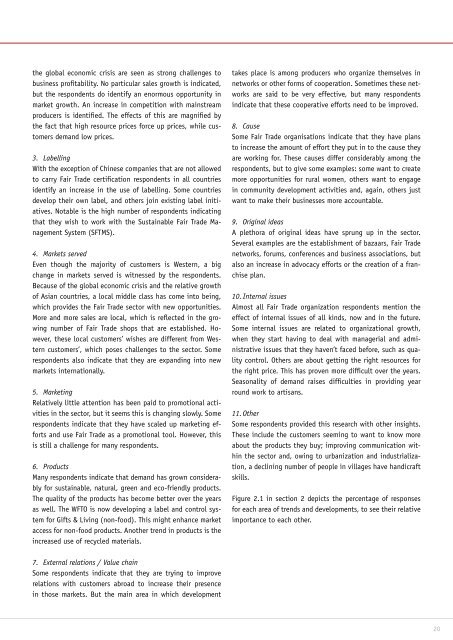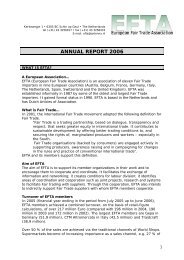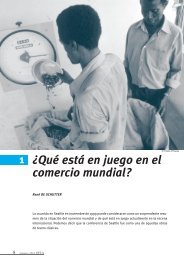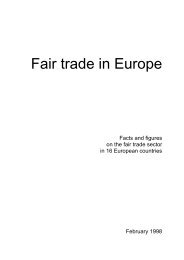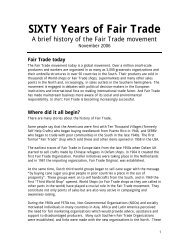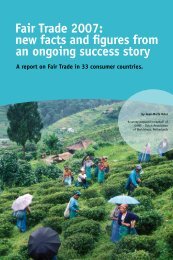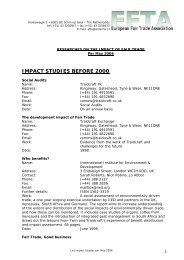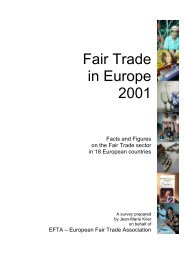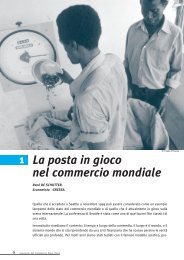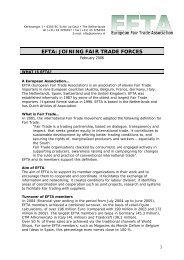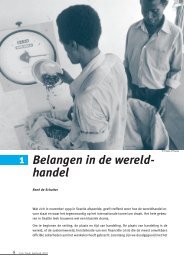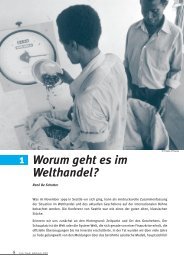2010 - European Fair Trade Association
2010 - European Fair Trade Association
2010 - European Fair Trade Association
You also want an ePaper? Increase the reach of your titles
YUMPU automatically turns print PDFs into web optimized ePapers that Google loves.
the global economic crisis are seen as strong challenges to<br />
business profitability. No particular sales growth is indicated,<br />
but the respondents do identify an enormous opportunity in<br />
market growth. An increase in competition with mainstream<br />
producers is identified. The effects of this are magnified by<br />
the fact that high resource prices force up prices, while customers<br />
demand low prices.<br />
3. Labelling<br />
With the exception of Chinese companies that are not allowed<br />
to carry <strong>Fair</strong> <strong>Trade</strong> certification respondents in all countries<br />
identify an increase in the use of labelling. Some countries<br />
develop their own label, and others join existing label initiatives.<br />
Notable is the high number of respondents indicating<br />
that they wish to work with the Sustainable <strong>Fair</strong> <strong>Trade</strong> Management<br />
System (SFTMS).<br />
4. Markets served<br />
Even though the majority of customers is Western, a big<br />
change in markets served is witnessed by the respondents.<br />
Because of the global economic crisis and the relative growth<br />
of Asian countries, a local middle class has come into being,<br />
which provides the <strong>Fair</strong> <strong>Trade</strong> sector with new opportunities.<br />
More and more sales are local, which is reflected in the growing<br />
number of <strong>Fair</strong> <strong>Trade</strong> shops that are established. However,<br />
these local customers’ wishes are different from Western<br />
customers’, which poses challenges to the sector. Some<br />
respondents also indicate that they are expanding into new<br />
markets internationally.<br />
5. Marketing<br />
Relatively little attention has been paid to promotional activities<br />
in the sector, but it seems this is changing slowly. Some<br />
respondents indicate that they have scaled up marketing efforts<br />
and use <strong>Fair</strong> <strong>Trade</strong> as a promotional tool. However, this<br />
is still a challenge for many respondents.<br />
6. Products<br />
Many respondents indicate that demand has grown considerably<br />
for sustainable, natural, green and eco-friendly products.<br />
The quality of the products has become better over the years<br />
as well. The WFTO is now developing a label and control system<br />
for Gifts & Living (non-food). This might enhance market<br />
access for non-food products. Another trend in products is the<br />
increased use of recycled materials.<br />
takes place is among producers who organize themselves in<br />
networks or other forms of cooperation. Sometimes these networks<br />
are said to be very effective, but many respondents<br />
indicate that these cooperative efforts need to be improved.<br />
8. Cause<br />
Some <strong>Fair</strong> <strong>Trade</strong> organisations indicate that they have plans<br />
to increase the amount of effort they put in to the cause they<br />
are working for. These causes differ considerably among the<br />
respondents, but to give some examples: some want to create<br />
more opportunities for rural women, others want to engage<br />
in community development activities and, again, others just<br />
want to make their businesses more accountable.<br />
9. Original ideas<br />
A plethora of original ideas have sprung up in the sector.<br />
Several examples are the establishment of bazaars, <strong>Fair</strong> <strong>Trade</strong><br />
networks, forums, conferences and business associations, but<br />
also an increase in advocacy efforts or the creation of a franchise<br />
plan.<br />
10. Internal issues<br />
Almost all <strong>Fair</strong> <strong>Trade</strong> organization respondents mention the<br />
effect of internal issues of all kinds, now and in the future.<br />
Some internal issues are related to organizational growth,<br />
when they start having to deal with managerial and administrative<br />
issues that they haven’t faced before, such as quality<br />
control. Others are about getting the right resources for<br />
the right price. This has proven more difficult over the years.<br />
Seasonality of demand raises difficulties in providing year<br />
round work to artisans.<br />
11. Other<br />
Some respondents provided this research with other insights.<br />
These include the customers seeming to want to know more<br />
about the products they buy; improving communication within<br />
the sector and, owing to urbanization and industrialization,<br />
a declining number of people in villages have handicraft<br />
skills.<br />
Figure 2.1 in section 2 depicts the percentage of responses<br />
for each area of trends and developments, to see their relative<br />
importance to each other.<br />
7. External relations / Value chain<br />
Some respondents indicate that they are trying to improve<br />
relations with customers abroad to increase their presence<br />
in those markets. But the main area in which development<br />
20


